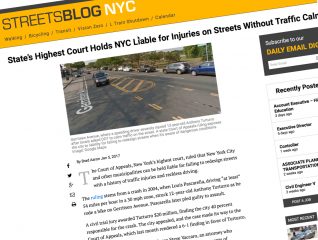
It happens way too often: Someone is seriously injured or killed at a location that’s a known traffic safety hot-spot. As an activist, it’s infuriating. I can only imagine what it’s like for the family and friends of victims.
After years of assuming cities had blanket immunity from liability when it came to street design decisions, a recent decision by New York’s highest court has thrown that into question. The court found that the City of New York can be held partly liable for a man’s death because they knew the road encouraged speeding and unsafe driving but they failed to study and implement measures to mitigate the risk.
The ruling is being hailed as a “landmark” and “game-changing” decision by New York City nonprofit organization Transportation Alternatives. Here’s what they said in a statement last week:
“The New York high court just ruled that the City can be held liable for failing to study and implement traffic calming measures, which the jury determined were a major factor contributing to the crash. In a 2004 incident, the driver was traveling at 54 mph on Gerritsen Avenue, which had a speed limit of 30 mph. Prior to the incident, the City had been advised by local residents, elected officials, and the Department of Transportation that speeding was common on the street, but that no sufficient speed study or traffic calming review was performed. The Court found the City liable for failing to adequately study and mitigate the road conditions that contributed to the speeding, stating that “an unjustifiable delay in implementing a remedial plan constitutes a breach of the municipality’s duty to the public.”
Experts testified during the trial that “it was known among traffic engineers that straight, wide roads” that lack pedestrian-friendly features “encourage speeding because drivers feel more comfortable on roadways with those characteristics.” The Court distinguished these types of thoroughfares from streets that have traffic calming measures in place, which “cause drivers to be more cautious” and “are known to reduce the overall speed on roadways.” The Court took NYC to task, noting that “[e]ven the City’s expert agreed that the design characteristics of a roadway influence driver speed, and that people generally drive faster on wide, straight roadways, regardless of the posted speed limit.” The jury and the Court relied in part on this evidence for their decision. The ruling is a major development because it means the City can potentially be held liable for unsafe street designs.”
Upon hearing about the ruling I immediately thought of several Portland cases where people have been killed in sections of roadway with notorious backgrounds: Fallon Smart was hit by a man driving 60 mph in a 30 mph zone on SE Hawthorne Blvd and several nearby business owners and activists said they’ve have been complaining about speeding in that section of road for years; Martin Greenough was hit and killed while biking on a section of Lombard that had been flagged several times*; Mitch York died after being hit by a speeding driver on the St. Johns Bridge — a bridge with a design that is so unsafe it nearly led to a lawsuit by bike advocates.
Advertisement
We asked local lawyers how this ruling in New York might influence Oregon cases.
Charley Gee is a personal injury lawyer who specializes in biking and walking cases. He said that while the ruling won’t have direct, precedent-setting standing in Oregon law, it could have an impact. “A court could, if a similar case was brought in Oregon, look at the New York case to guide their own interpretation of the law and decide if Oregon law provides for a similar ruling or a split between the states.”
Lawyer and Bicycling Magazine columnist Bob Mionske said the decision in New York is a watershed moment for cycling advocates. “Traffic violence is the issue for advocacy efforts and this decision opens the door to holding liable the only party who can make the changes necessary for a safer transportation environment. I applaud their decision as all cycling advocates should.” Mionske said he thinks the ruling will lead to more lawsuits against public entities for unsafe road design. Whether or not courts will side with victims remains to be seen.
New York has weaker immunity laws than Oregon does (meaning it’s easier to sue the state). In Oregon, Mionske said, we have “limited state immunity”. Discretionary decisions (ones that require some level of judgment from the agency) are immune, whereas ministerial acts (merely applying an existing law or policy) are not. The argument would be whether or not unsafe road design is discretionary or ministerial.
“My guess is that the Turturro decision out of New York Court Of Appeals,” Mionski shared, “will be used as support in other jurisdictions and we will see some jurisdictions agree with NY and others continue to apply their state’s sovereign immunity statutes, especially in states with ‘absolute’ state immunity.”
For a more detailed look at the ruling and its implications for transportation reform activists, check out the coverage (and comments) from Streetsblog NYC.
*After Greenough’s death ODOT promised they would do an analysis of the road design. We’ve asked for that analysis and will share what we find out.
— Jonathan Maus: (503) 706-8804, @jonathan_maus on Twitter and jonathan@bikeportland.org
BikePortland is supported by the community (that means you!). Please become a subscriber or make a donation today.

